Business Operations Report: Accounting, HR, Motivation, Leadership
VerifiedAdded on 2022/12/19
|10
|2460
|36
Report
AI Summary
This report delves into the core aspects of business operations, offering a comprehensive overview of key functions and concepts. It begins with an introduction to business operations, emphasizing their role in generating value and growth. The report then explores the importance of accounting, highlighting its role in recording, analyzing, and interpreting financial transactions, and its impact on decision-making and planning. It also examines various HR functions, including planning, recruitment, training, and development, along with employment legislation. The report analyzes the profit and loss account of Tesco, followed by an in-depth discussion on team development stages, organizational structures, and the roles and responsibilities within a team. Furthermore, it explores different motivation theories, such as Maslow's hierarchy, Mayo's theory, and McClelland's theory, and various leadership styles including autocratic and democratic approaches. The report concludes with a summary of the key findings, emphasizing the interconnectedness of these elements in driving successful business operations.
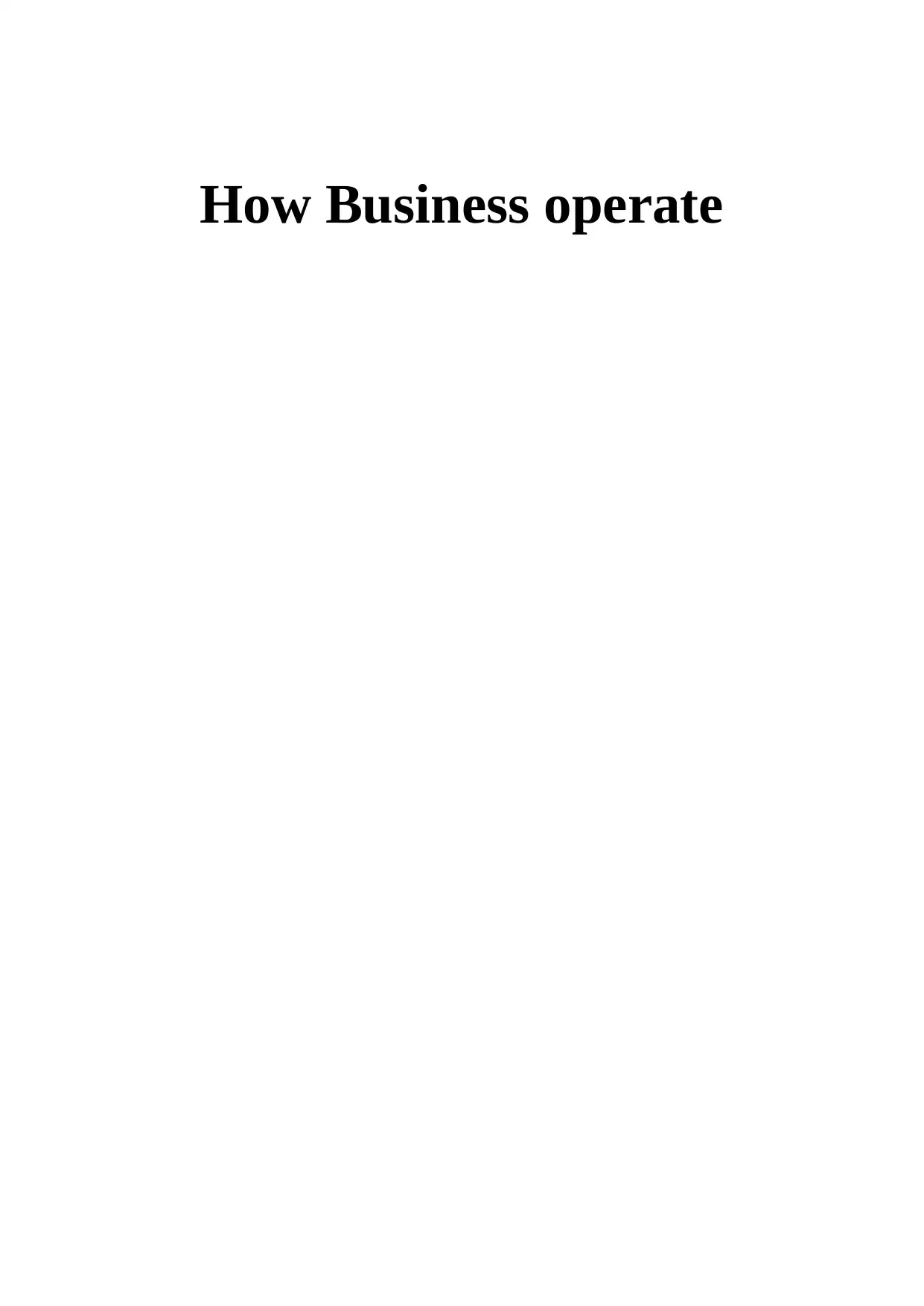
How Business operate
Paraphrase This Document
Need a fresh take? Get an instant paraphrase of this document with our AI Paraphraser
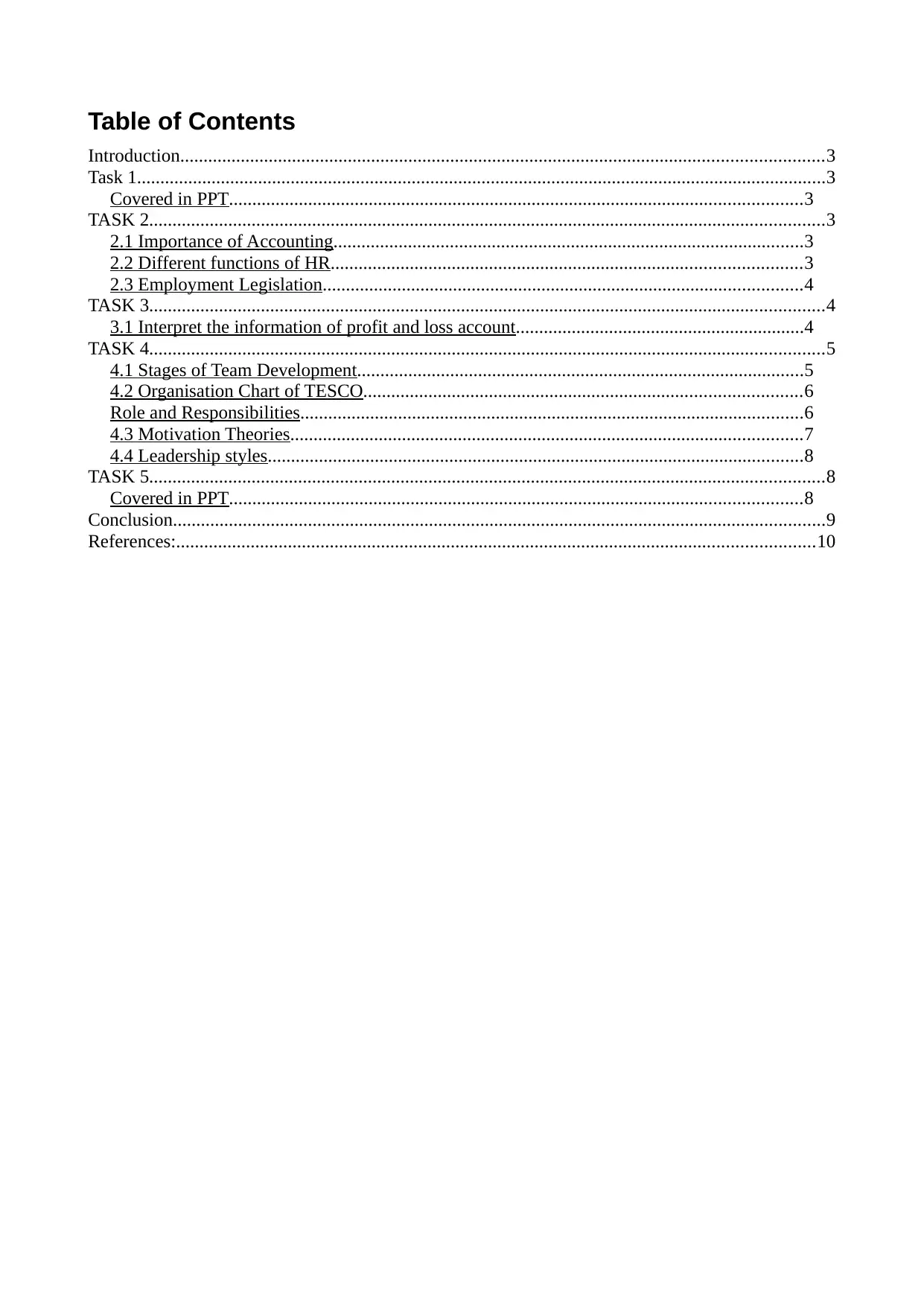
Table of Contents
Introduction..........................................................................................................................................3
Task 1....................................................................................................................................................3
Covered in PPT...........................................................................................................................3
TASK 2.................................................................................................................................................3
2.1 Importance of Accounting.....................................................................................................3
2.2 Different functions of HR.....................................................................................................3
2.3 Employment Legislation.......................................................................................................4
TASK 3.................................................................................................................................................4
3.1 Interpret the information of profit and loss account..............................................................4
TASK 4.................................................................................................................................................5
4.1 Stages of Team Development................................................................................................5
4.2 Organisation Chart of TESCO..............................................................................................6
Role and Responsibilities............................................................................................................6
4.3 Motivation Theories..............................................................................................................7
4.4 Leadership styles...................................................................................................................8
TASK 5.................................................................................................................................................8
Covered in PPT...........................................................................................................................8
Conclusion............................................................................................................................................9
References:.........................................................................................................................................10
Introduction..........................................................................................................................................3
Task 1....................................................................................................................................................3
Covered in PPT...........................................................................................................................3
TASK 2.................................................................................................................................................3
2.1 Importance of Accounting.....................................................................................................3
2.2 Different functions of HR.....................................................................................................3
2.3 Employment Legislation.......................................................................................................4
TASK 3.................................................................................................................................................4
3.1 Interpret the information of profit and loss account..............................................................4
TASK 4.................................................................................................................................................5
4.1 Stages of Team Development................................................................................................5
4.2 Organisation Chart of TESCO..............................................................................................6
Role and Responsibilities............................................................................................................6
4.3 Motivation Theories..............................................................................................................7
4.4 Leadership styles...................................................................................................................8
TASK 5.................................................................................................................................................8
Covered in PPT...........................................................................................................................8
Conclusion............................................................................................................................................9
References:.........................................................................................................................................10
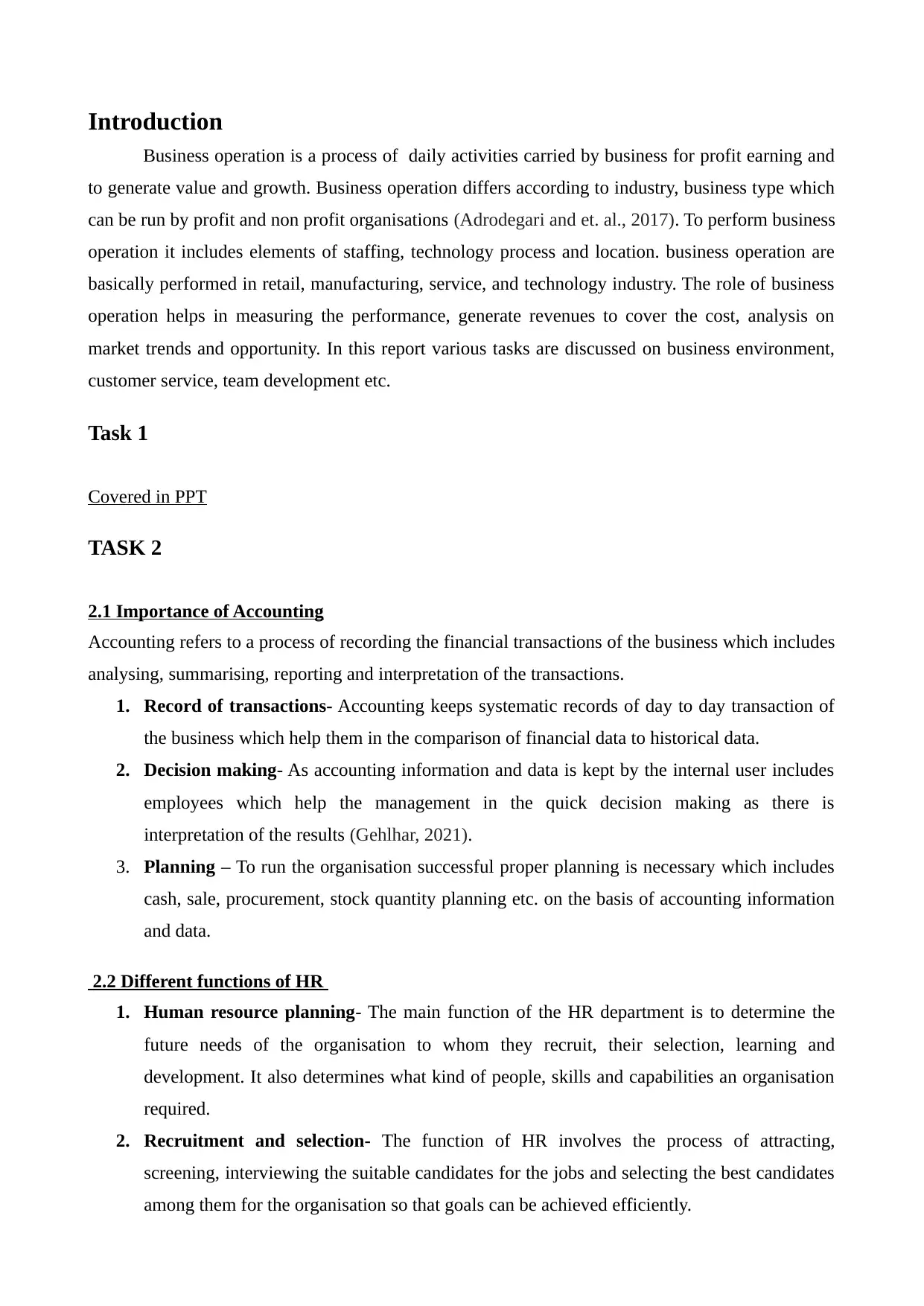
Introduction
Business operation is a process of daily activities carried by business for profit earning and
to generate value and growth. Business operation differs according to industry, business type which
can be run by profit and non profit organisations (Adrodegari and et. al., 2017). To perform business
operation it includes elements of staffing, technology process and location. business operation are
basically performed in retail, manufacturing, service, and technology industry. The role of business
operation helps in measuring the performance, generate revenues to cover the cost, analysis on
market trends and opportunity. In this report various tasks are discussed on business environment,
customer service, team development etc.
Task 1
Covered in PPT
TASK 2
2.1 Importance of Accounting
Accounting refers to a process of recording the financial transactions of the business which includes
analysing, summarising, reporting and interpretation of the transactions.
1. Record of transactions- Accounting keeps systematic records of day to day transaction of
the business which help them in the comparison of financial data to historical data.
2. Decision making- As accounting information and data is kept by the internal user includes
employees which help the management in the quick decision making as there is
interpretation of the results (Gehlhar, 2021).
3. Planning – To run the organisation successful proper planning is necessary which includes
cash, sale, procurement, stock quantity planning etc. on the basis of accounting information
and data.
2.2 Different functions of HR
1. Human resource planning- The main function of the HR department is to determine the
future needs of the organisation to whom they recruit, their selection, learning and
development. It also determines what kind of people, skills and capabilities an organisation
required.
2. Recruitment and selection- The function of HR involves the process of attracting,
screening, interviewing the suitable candidates for the jobs and selecting the best candidates
among them for the organisation so that goals can be achieved efficiently.
Business operation is a process of daily activities carried by business for profit earning and
to generate value and growth. Business operation differs according to industry, business type which
can be run by profit and non profit organisations (Adrodegari and et. al., 2017). To perform business
operation it includes elements of staffing, technology process and location. business operation are
basically performed in retail, manufacturing, service, and technology industry. The role of business
operation helps in measuring the performance, generate revenues to cover the cost, analysis on
market trends and opportunity. In this report various tasks are discussed on business environment,
customer service, team development etc.
Task 1
Covered in PPT
TASK 2
2.1 Importance of Accounting
Accounting refers to a process of recording the financial transactions of the business which includes
analysing, summarising, reporting and interpretation of the transactions.
1. Record of transactions- Accounting keeps systematic records of day to day transaction of
the business which help them in the comparison of financial data to historical data.
2. Decision making- As accounting information and data is kept by the internal user includes
employees which help the management in the quick decision making as there is
interpretation of the results (Gehlhar, 2021).
3. Planning – To run the organisation successful proper planning is necessary which includes
cash, sale, procurement, stock quantity planning etc. on the basis of accounting information
and data.
2.2 Different functions of HR
1. Human resource planning- The main function of the HR department is to determine the
future needs of the organisation to whom they recruit, their selection, learning and
development. It also determines what kind of people, skills and capabilities an organisation
required.
2. Recruitment and selection- The function of HR involves the process of attracting,
screening, interviewing the suitable candidates for the jobs and selecting the best candidates
among them for the organisation so that goals can be achieved efficiently.
⊘ This is a preview!⊘
Do you want full access?
Subscribe today to unlock all pages.

Trusted by 1+ million students worldwide
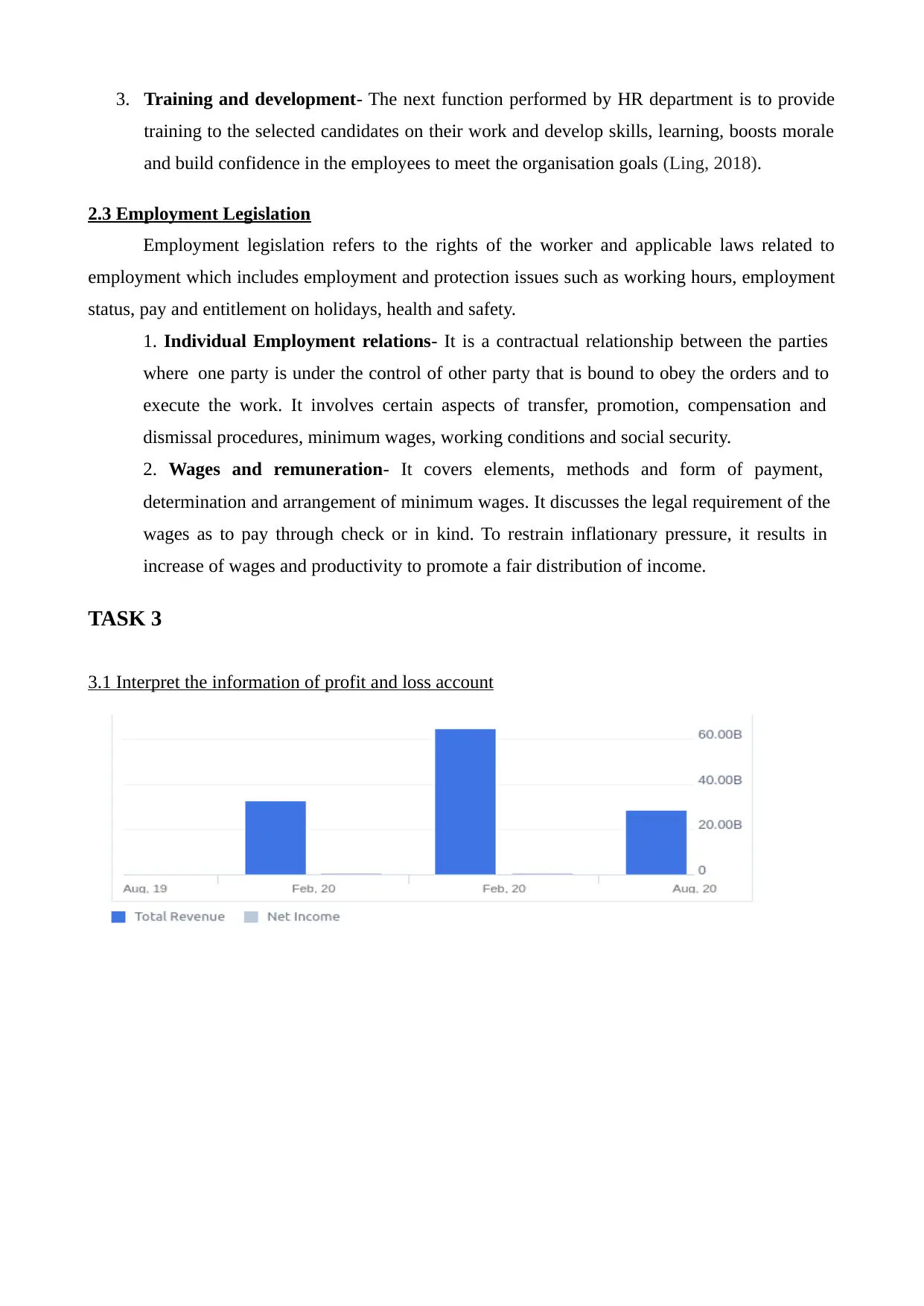
3. Training and development- The next function performed by HR department is to provide
training to the selected candidates on their work and develop skills, learning, boosts morale
and build confidence in the employees to meet the organisation goals (Ling, 2018).
2.3 Employment Legislation
Employment legislation refers to the rights of the worker and applicable laws related to
employment which includes employment and protection issues such as working hours, employment
status, pay and entitlement on holidays, health and safety.
1. Individual Employment relations- It is a contractual relationship between the parties
where one party is under the control of other party that is bound to obey the orders and to
execute the work. It involves certain aspects of transfer, promotion, compensation and
dismissal procedures, minimum wages, working conditions and social security.
2. Wages and remuneration- It covers elements, methods and form of payment,
determination and arrangement of minimum wages. It discusses the legal requirement of the
wages as to pay through check or in kind. To restrain inflationary pressure, it results in
increase of wages and productivity to promote a fair distribution of income.
TASK 3
3.1 Interpret the information of profit and loss account
training to the selected candidates on their work and develop skills, learning, boosts morale
and build confidence in the employees to meet the organisation goals (Ling, 2018).
2.3 Employment Legislation
Employment legislation refers to the rights of the worker and applicable laws related to
employment which includes employment and protection issues such as working hours, employment
status, pay and entitlement on holidays, health and safety.
1. Individual Employment relations- It is a contractual relationship between the parties
where one party is under the control of other party that is bound to obey the orders and to
execute the work. It involves certain aspects of transfer, promotion, compensation and
dismissal procedures, minimum wages, working conditions and social security.
2. Wages and remuneration- It covers elements, methods and form of payment,
determination and arrangement of minimum wages. It discusses the legal requirement of the
wages as to pay through check or in kind. To restrain inflationary pressure, it results in
increase of wages and productivity to promote a fair distribution of income.
TASK 3
3.1 Interpret the information of profit and loss account
Paraphrase This Document
Need a fresh take? Get an instant paraphrase of this document with our AI Paraphraser
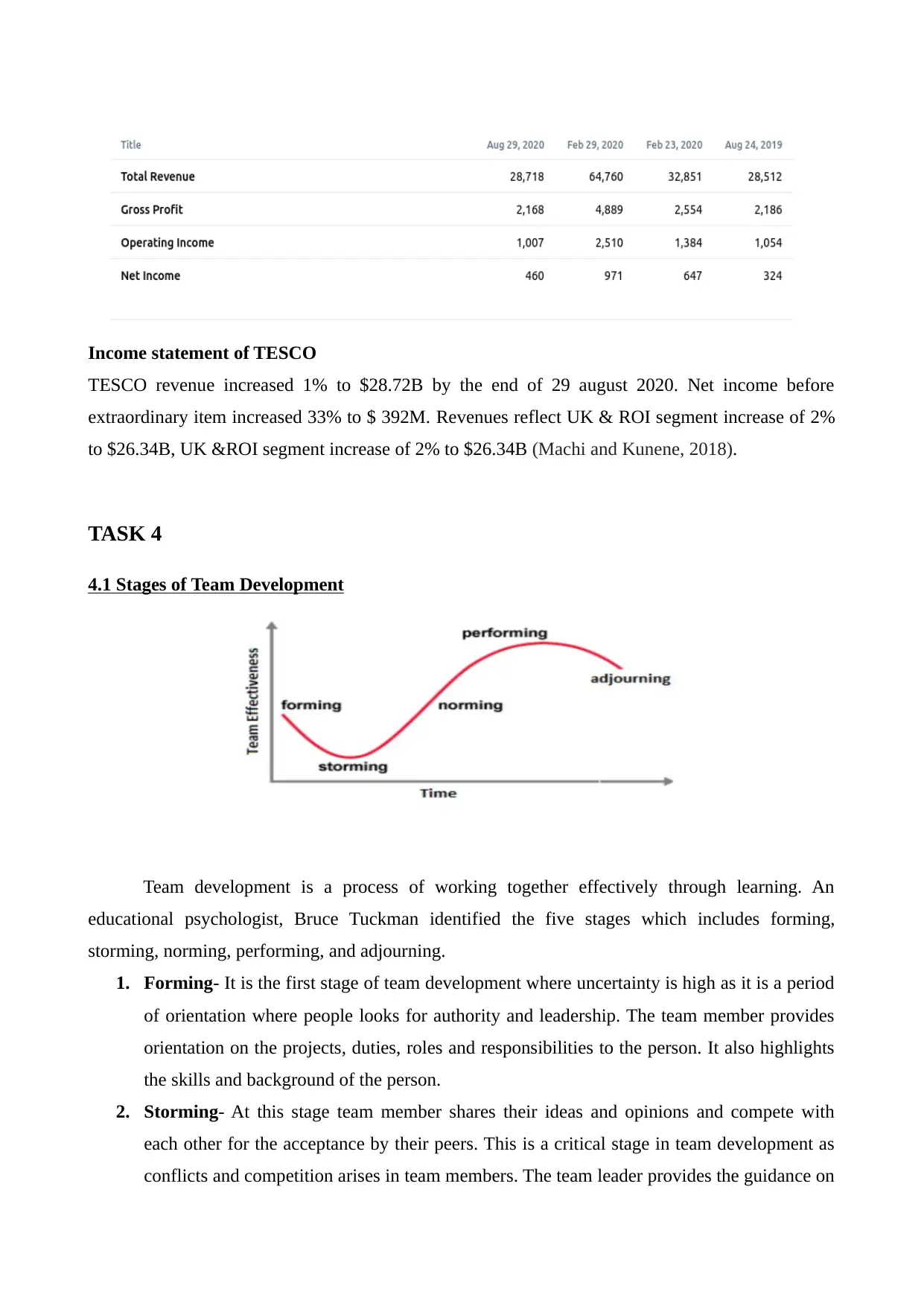
Income statement of TESCO
TESCO revenue increased 1% to $28.72B by the end of 29 august 2020. Net income before
extraordinary item increased 33% to $ 392M. Revenues reflect UK & ROI segment increase of 2%
to $26.34B, UK &ROI segment increase of 2% to $26.34B (Machi and Kunene, 2018).
TASK 4
4.1 Stages of Team Development
Team development is a process of working together effectively through learning. An
educational psychologist, Bruce Tuckman identified the five stages which includes forming,
storming, norming, performing, and adjourning.
1. Forming- It is the first stage of team development where uncertainty is high as it is a period
of orientation where people looks for authority and leadership. The team member provides
orientation on the projects, duties, roles and responsibilities to the person. It also highlights
the skills and background of the person.
2. Storming- At this stage team member shares their ideas and opinions and compete with
each other for the acceptance by their peers. This is a critical stage in team development as
conflicts and competition arises in team members. The team leader provides the guidance on
TESCO revenue increased 1% to $28.72B by the end of 29 august 2020. Net income before
extraordinary item increased 33% to $ 392M. Revenues reflect UK & ROI segment increase of 2%
to $26.34B, UK &ROI segment increase of 2% to $26.34B (Machi and Kunene, 2018).
TASK 4
4.1 Stages of Team Development
Team development is a process of working together effectively through learning. An
educational psychologist, Bruce Tuckman identified the five stages which includes forming,
storming, norming, performing, and adjourning.
1. Forming- It is the first stage of team development where uncertainty is high as it is a period
of orientation where people looks for authority and leadership. The team member provides
orientation on the projects, duties, roles and responsibilities to the person. It also highlights
the skills and background of the person.
2. Storming- At this stage team member shares their ideas and opinions and compete with
each other for the acceptance by their peers. This is a critical stage in team development as
conflicts and competition arises in team members. The team leader provides the guidance on
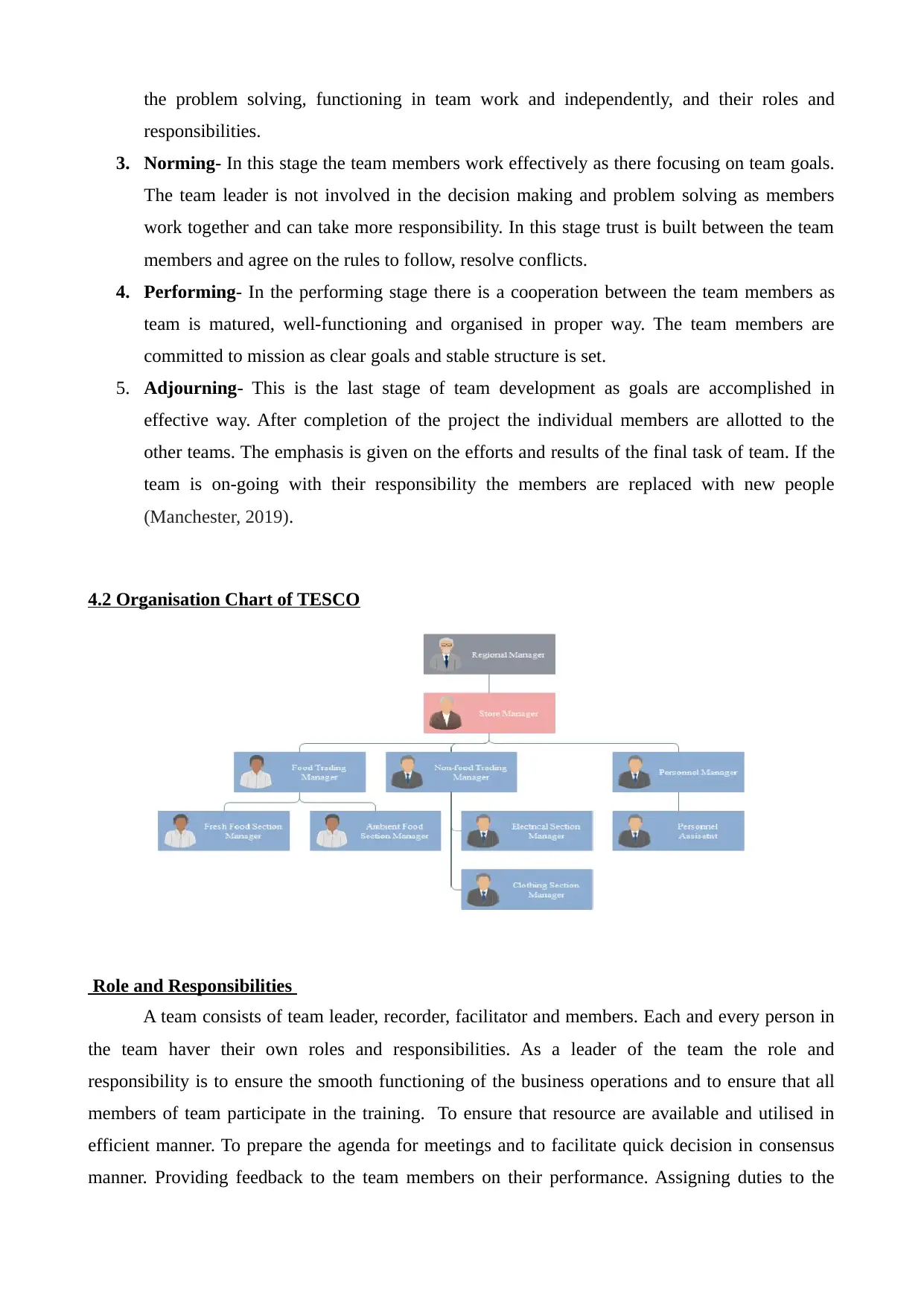
the problem solving, functioning in team work and independently, and their roles and
responsibilities.
3. Norming- In this stage the team members work effectively as there focusing on team goals.
The team leader is not involved in the decision making and problem solving as members
work together and can take more responsibility. In this stage trust is built between the team
members and agree on the rules to follow, resolve conflicts.
4. Performing- In the performing stage there is a cooperation between the team members as
team is matured, well-functioning and organised in proper way. The team members are
committed to mission as clear goals and stable structure is set.
5. Adjourning- This is the last stage of team development as goals are accomplished in
effective way. After completion of the project the individual members are allotted to the
other teams. The emphasis is given on the efforts and results of the final task of team. If the
team is on-going with their responsibility the members are replaced with new people
(Manchester, 2019).
4.2 Organisation Chart of TESCO
Role and Responsibilities
A team consists of team leader, recorder, facilitator and members. Each and every person in
the team haver their own roles and responsibilities. As a leader of the team the role and
responsibility is to ensure the smooth functioning of the business operations and to ensure that all
members of team participate in the training. To ensure that resource are available and utilised in
efficient manner. To prepare the agenda for meetings and to facilitate quick decision in consensus
manner. Providing feedback to the team members on their performance. Assigning duties to the
responsibilities.
3. Norming- In this stage the team members work effectively as there focusing on team goals.
The team leader is not involved in the decision making and problem solving as members
work together and can take more responsibility. In this stage trust is built between the team
members and agree on the rules to follow, resolve conflicts.
4. Performing- In the performing stage there is a cooperation between the team members as
team is matured, well-functioning and organised in proper way. The team members are
committed to mission as clear goals and stable structure is set.
5. Adjourning- This is the last stage of team development as goals are accomplished in
effective way. After completion of the project the individual members are allotted to the
other teams. The emphasis is given on the efforts and results of the final task of team. If the
team is on-going with their responsibility the members are replaced with new people
(Manchester, 2019).
4.2 Organisation Chart of TESCO
Role and Responsibilities
A team consists of team leader, recorder, facilitator and members. Each and every person in
the team haver their own roles and responsibilities. As a leader of the team the role and
responsibility is to ensure the smooth functioning of the business operations and to ensure that all
members of team participate in the training. To ensure that resource are available and utilised in
efficient manner. To prepare the agenda for meetings and to facilitate quick decision in consensus
manner. Providing feedback to the team members on their performance. Assigning duties to the
⊘ This is a preview!⊘
Do you want full access?
Subscribe today to unlock all pages.

Trusted by 1+ million students worldwide
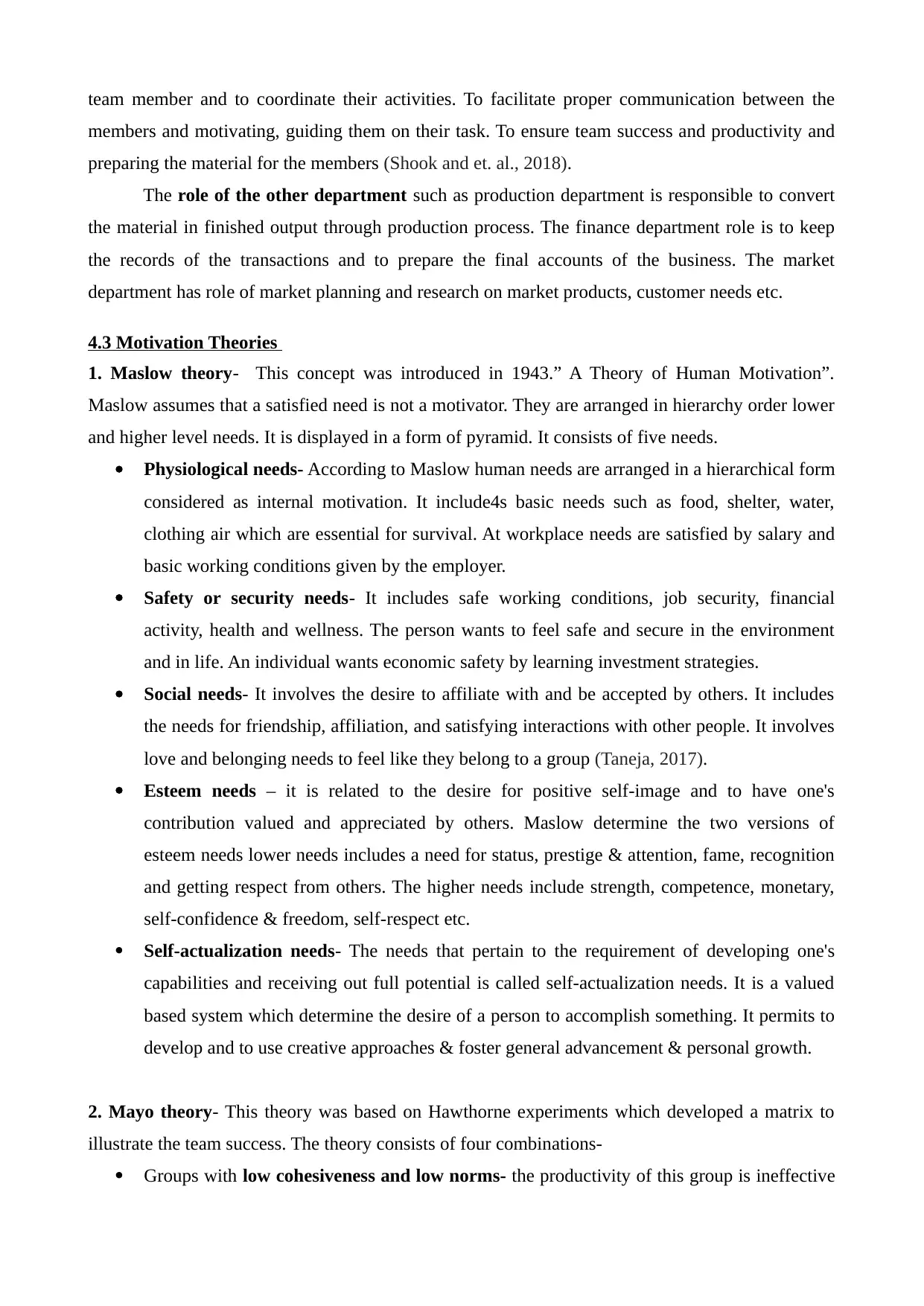
team member and to coordinate their activities. To facilitate proper communication between the
members and motivating, guiding them on their task. To ensure team success and productivity and
preparing the material for the members (Shook and et. al., 2018).
The role of the other department such as production department is responsible to convert
the material in finished output through production process. The finance department role is to keep
the records of the transactions and to prepare the final accounts of the business. The market
department has role of market planning and research on market products, customer needs etc.
4.3 Motivation Theories
1. Maslow theory- This concept was introduced in 1943.” A Theory of Human Motivation”.
Maslow assumes that a satisfied need is not a motivator. They are arranged in hierarchy order lower
and higher level needs. It is displayed in a form of pyramid. It consists of five needs.
Physiological needs- According to Maslow human needs are arranged in a hierarchical form
considered as internal motivation. It include4s basic needs such as food, shelter, water,
clothing air which are essential for survival. At workplace needs are satisfied by salary and
basic working conditions given by the employer.
Safety or security needs- It includes safe working conditions, job security, financial
activity, health and wellness. The person wants to feel safe and secure in the environment
and in life. An individual wants economic safety by learning investment strategies.
Social needs- It involves the desire to affiliate with and be accepted by others. It includes
the needs for friendship, affiliation, and satisfying interactions with other people. It involves
love and belonging needs to feel like they belong to a group (Taneja, 2017).
Esteem needs – it is related to the desire for positive self-image and to have one's
contribution valued and appreciated by others. Maslow determine the two versions of
esteem needs lower needs includes a need for status, prestige & attention, fame, recognition
and getting respect from others. The higher needs include strength, competence, monetary,
self-confidence & freedom, self-respect etc.
Self-actualization needs- The needs that pertain to the requirement of developing one's
capabilities and receiving out full potential is called self-actualization needs. It is a valued
based system which determine the desire of a person to accomplish something. It permits to
develop and to use creative approaches & foster general advancement & personal growth.
2. Mayo theory- This theory was based on Hawthorne experiments which developed a matrix to
illustrate the team success. The theory consists of four combinations-
Groups with low cohesiveness and low norms- the productivity of this group is ineffective
members and motivating, guiding them on their task. To ensure team success and productivity and
preparing the material for the members (Shook and et. al., 2018).
The role of the other department such as production department is responsible to convert
the material in finished output through production process. The finance department role is to keep
the records of the transactions and to prepare the final accounts of the business. The market
department has role of market planning and research on market products, customer needs etc.
4.3 Motivation Theories
1. Maslow theory- This concept was introduced in 1943.” A Theory of Human Motivation”.
Maslow assumes that a satisfied need is not a motivator. They are arranged in hierarchy order lower
and higher level needs. It is displayed in a form of pyramid. It consists of five needs.
Physiological needs- According to Maslow human needs are arranged in a hierarchical form
considered as internal motivation. It include4s basic needs such as food, shelter, water,
clothing air which are essential for survival. At workplace needs are satisfied by salary and
basic working conditions given by the employer.
Safety or security needs- It includes safe working conditions, job security, financial
activity, health and wellness. The person wants to feel safe and secure in the environment
and in life. An individual wants economic safety by learning investment strategies.
Social needs- It involves the desire to affiliate with and be accepted by others. It includes
the needs for friendship, affiliation, and satisfying interactions with other people. It involves
love and belonging needs to feel like they belong to a group (Taneja, 2017).
Esteem needs – it is related to the desire for positive self-image and to have one's
contribution valued and appreciated by others. Maslow determine the two versions of
esteem needs lower needs includes a need for status, prestige & attention, fame, recognition
and getting respect from others. The higher needs include strength, competence, monetary,
self-confidence & freedom, self-respect etc.
Self-actualization needs- The needs that pertain to the requirement of developing one's
capabilities and receiving out full potential is called self-actualization needs. It is a valued
based system which determine the desire of a person to accomplish something. It permits to
develop and to use creative approaches & foster general advancement & personal growth.
2. Mayo theory- This theory was based on Hawthorne experiments which developed a matrix to
illustrate the team success. The theory consists of four combinations-
Groups with low cohesiveness and low norms- the productivity of this group is ineffective
Paraphrase This Document
Need a fresh take? Get an instant paraphrase of this document with our AI Paraphraser
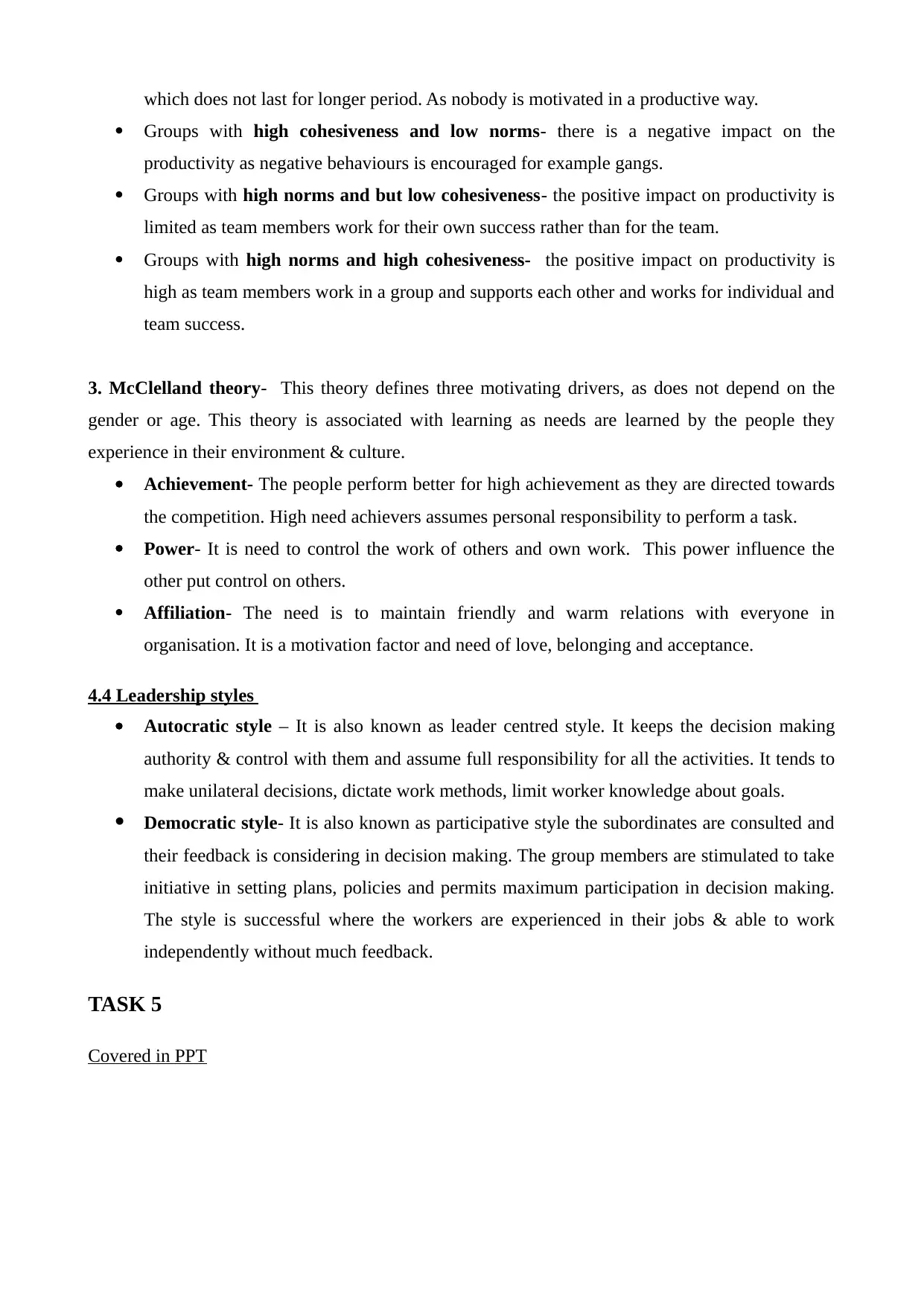
which does not last for longer period. As nobody is motivated in a productive way.
Groups with high cohesiveness and low norms- there is a negative impact on the
productivity as negative behaviours is encouraged for example gangs.
Groups with high norms and but low cohesiveness- the positive impact on productivity is
limited as team members work for their own success rather than for the team.
Groups with high norms and high cohesiveness- the positive impact on productivity is
high as team members work in a group and supports each other and works for individual and
team success.
3. McClelland theory- This theory defines three motivating drivers, as does not depend on the
gender or age. This theory is associated with learning as needs are learned by the people they
experience in their environment & culture.
Achievement- The people perform better for high achievement as they are directed towards
the competition. High need achievers assumes personal responsibility to perform a task.
Power- It is need to control the work of others and own work. This power influence the
other put control on others.
Affiliation- The need is to maintain friendly and warm relations with everyone in
organisation. It is a motivation factor and need of love, belonging and acceptance.
4.4 Leadership styles
Autocratic style – It is also known as leader centred style. It keeps the decision making
authority & control with them and assume full responsibility for all the activities. It tends to
make unilateral decisions, dictate work methods, limit worker knowledge about goals.
Democratic style- It is also known as participative style the subordinates are consulted and
their feedback is considering in decision making. The group members are stimulated to take
initiative in setting plans, policies and permits maximum participation in decision making.
The style is successful where the workers are experienced in their jobs & able to work
independently without much feedback.
TASK 5
Covered in PPT
Groups with high cohesiveness and low norms- there is a negative impact on the
productivity as negative behaviours is encouraged for example gangs.
Groups with high norms and but low cohesiveness- the positive impact on productivity is
limited as team members work for their own success rather than for the team.
Groups with high norms and high cohesiveness- the positive impact on productivity is
high as team members work in a group and supports each other and works for individual and
team success.
3. McClelland theory- This theory defines three motivating drivers, as does not depend on the
gender or age. This theory is associated with learning as needs are learned by the people they
experience in their environment & culture.
Achievement- The people perform better for high achievement as they are directed towards
the competition. High need achievers assumes personal responsibility to perform a task.
Power- It is need to control the work of others and own work. This power influence the
other put control on others.
Affiliation- The need is to maintain friendly and warm relations with everyone in
organisation. It is a motivation factor and need of love, belonging and acceptance.
4.4 Leadership styles
Autocratic style – It is also known as leader centred style. It keeps the decision making
authority & control with them and assume full responsibility for all the activities. It tends to
make unilateral decisions, dictate work methods, limit worker knowledge about goals.
Democratic style- It is also known as participative style the subordinates are consulted and
their feedback is considering in decision making. The group members are stimulated to take
initiative in setting plans, policies and permits maximum participation in decision making.
The style is successful where the workers are experienced in their jobs & able to work
independently without much feedback.
TASK 5
Covered in PPT
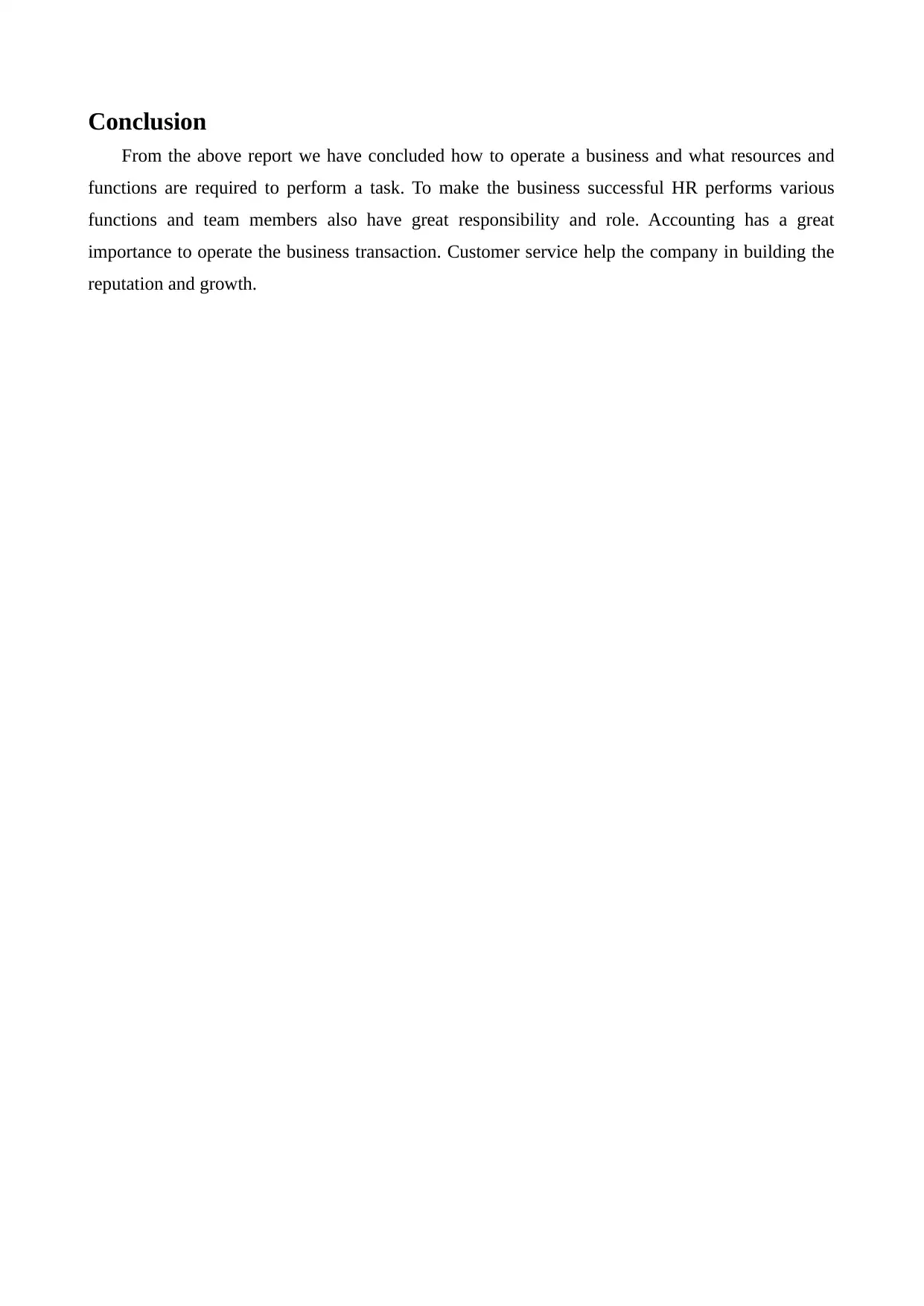
Conclusion
From the above report we have concluded how to operate a business and what resources and
functions are required to perform a task. To make the business successful HR performs various
functions and team members also have great responsibility and role. Accounting has a great
importance to operate the business transaction. Customer service help the company in building the
reputation and growth.
From the above report we have concluded how to operate a business and what resources and
functions are required to perform a task. To make the business successful HR performs various
functions and team members also have great responsibility and role. Accounting has a great
importance to operate the business transaction. Customer service help the company in building the
reputation and growth.
⊘ This is a preview!⊘
Do you want full access?
Subscribe today to unlock all pages.

Trusted by 1+ million students worldwide
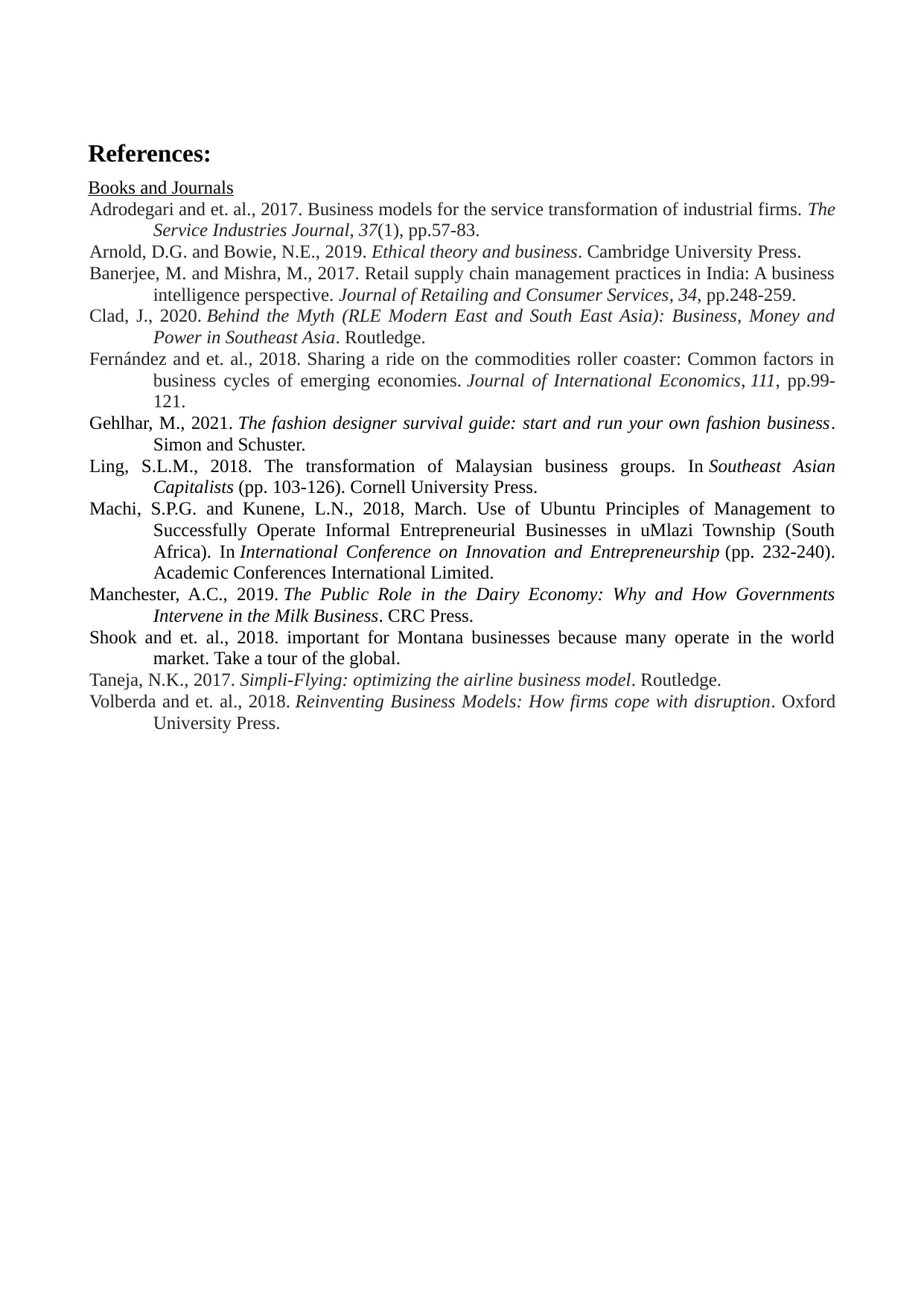
References:
Books and Journals
Adrodegari and et. al., 2017. Business models for the service transformation of industrial firms. The
Service Industries Journal, 37(1), pp.57-83.
Arnold, D.G. and Bowie, N.E., 2019. Ethical theory and business. Cambridge University Press.
Banerjee, M. and Mishra, M., 2017. Retail supply chain management practices in India: A business
intelligence perspective. Journal of Retailing and Consumer Services, 34, pp.248-259.
Clad, J., 2020. Behind the Myth (RLE Modern East and South East Asia): Business, Money and
Power in Southeast Asia. Routledge.
Fernández and et. al., 2018. Sharing a ride on the commodities roller coaster: Common factors in
business cycles of emerging economies. Journal of International Economics, 111, pp.99-
121.
Gehlhar, M., 2021. The fashion designer survival guide: start and run your own fashion business.
Simon and Schuster.
Ling, S.L.M., 2018. The transformation of Malaysian business groups. In Southeast Asian
Capitalists (pp. 103-126). Cornell University Press.
Machi, S.P.G. and Kunene, L.N., 2018, March. Use of Ubuntu Principles of Management to
Successfully Operate Informal Entrepreneurial Businesses in uMlazi Township (South
Africa). In International Conference on Innovation and Entrepreneurship (pp. 232-240).
Academic Conferences International Limited.
Manchester, A.C., 2019. The Public Role in the Dairy Economy: Why and How Governments
Intervene in the Milk Business. CRC Press.
Shook and et. al., 2018. important for Montana businesses because many operate in the world
market. Take a tour of the global.
Taneja, N.K., 2017. Simpli-Flying: optimizing the airline business model. Routledge.
Volberda and et. al., 2018. Reinventing Business Models: How firms cope with disruption. Oxford
University Press.
Books and Journals
Adrodegari and et. al., 2017. Business models for the service transformation of industrial firms. The
Service Industries Journal, 37(1), pp.57-83.
Arnold, D.G. and Bowie, N.E., 2019. Ethical theory and business. Cambridge University Press.
Banerjee, M. and Mishra, M., 2017. Retail supply chain management practices in India: A business
intelligence perspective. Journal of Retailing and Consumer Services, 34, pp.248-259.
Clad, J., 2020. Behind the Myth (RLE Modern East and South East Asia): Business, Money and
Power in Southeast Asia. Routledge.
Fernández and et. al., 2018. Sharing a ride on the commodities roller coaster: Common factors in
business cycles of emerging economies. Journal of International Economics, 111, pp.99-
121.
Gehlhar, M., 2021. The fashion designer survival guide: start and run your own fashion business.
Simon and Schuster.
Ling, S.L.M., 2018. The transformation of Malaysian business groups. In Southeast Asian
Capitalists (pp. 103-126). Cornell University Press.
Machi, S.P.G. and Kunene, L.N., 2018, March. Use of Ubuntu Principles of Management to
Successfully Operate Informal Entrepreneurial Businesses in uMlazi Township (South
Africa). In International Conference on Innovation and Entrepreneurship (pp. 232-240).
Academic Conferences International Limited.
Manchester, A.C., 2019. The Public Role in the Dairy Economy: Why and How Governments
Intervene in the Milk Business. CRC Press.
Shook and et. al., 2018. important for Montana businesses because many operate in the world
market. Take a tour of the global.
Taneja, N.K., 2017. Simpli-Flying: optimizing the airline business model. Routledge.
Volberda and et. al., 2018. Reinventing Business Models: How firms cope with disruption. Oxford
University Press.
1 out of 10
Related Documents
Your All-in-One AI-Powered Toolkit for Academic Success.
+13062052269
info@desklib.com
Available 24*7 on WhatsApp / Email
![[object Object]](/_next/static/media/star-bottom.7253800d.svg)
Unlock your academic potential
Copyright © 2020–2025 A2Z Services. All Rights Reserved. Developed and managed by ZUCOL.





